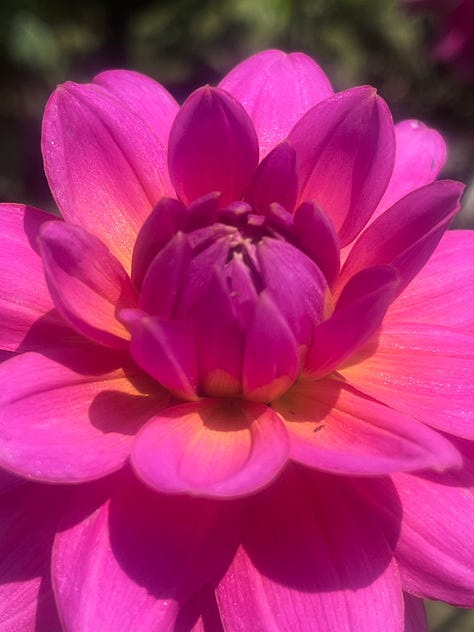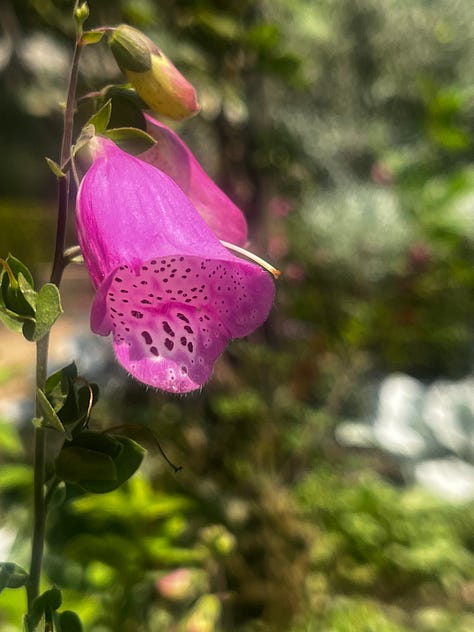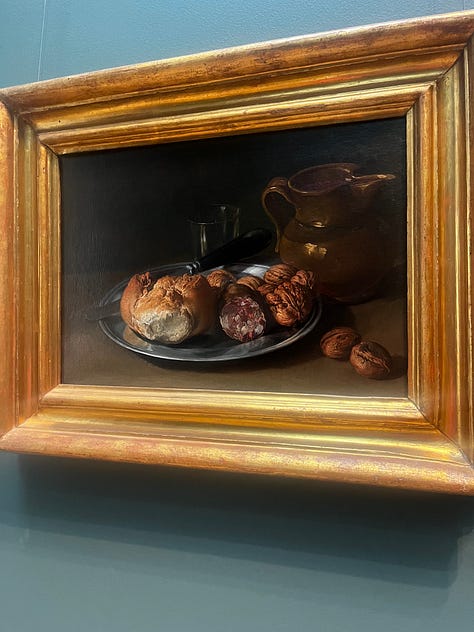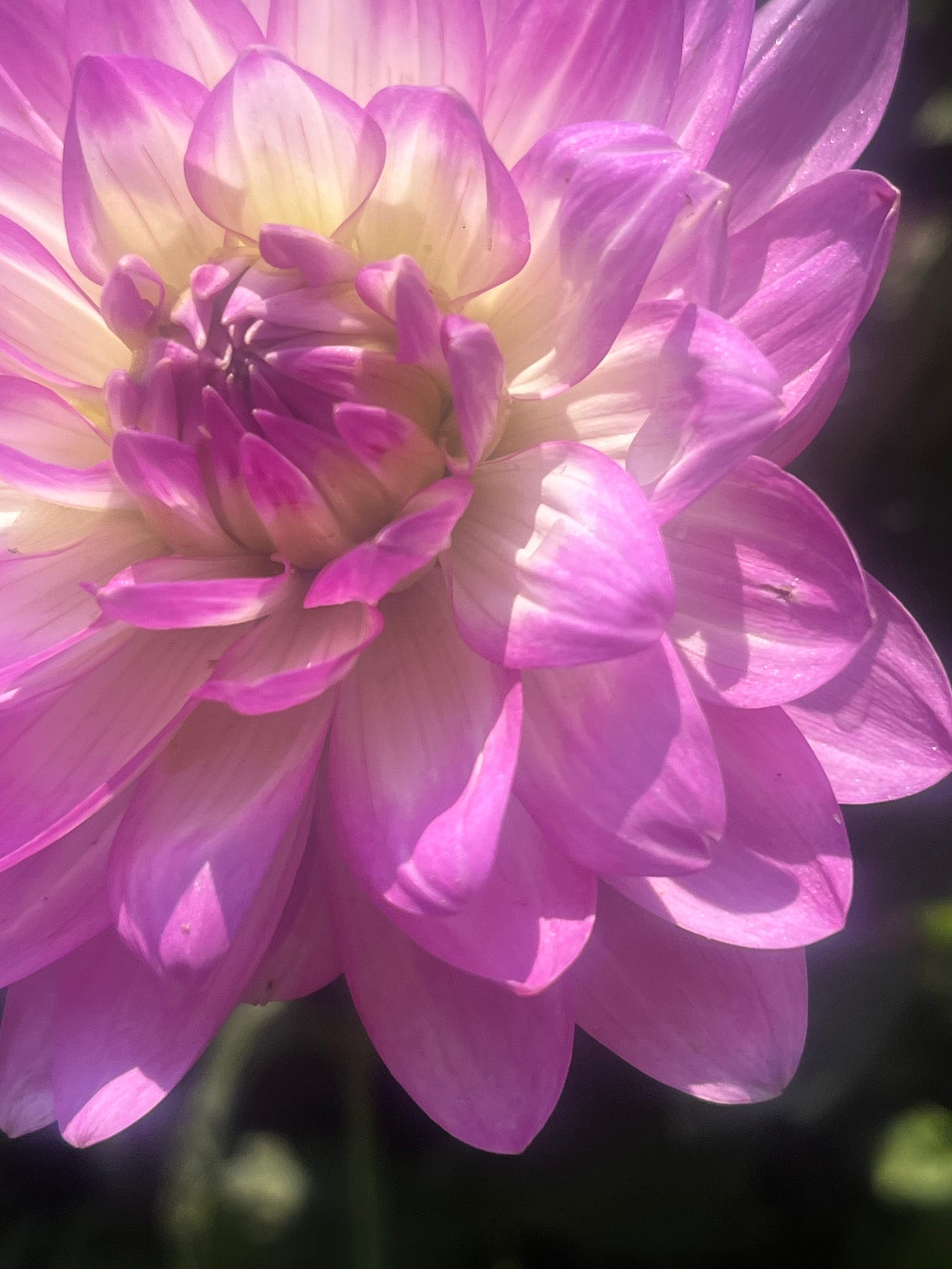Visio Divina is the spiritual practice of intentionally, mindfully pausing before an image, piece of art, or scene and discerning the message or sacred whisper. Images for Visio Divina are often well-known paintings from the Romantic era or other sacred art.
I’m interested in practical, approachable practices that seamlessly weave into ordinary days. “Camera Roll Visio Divina” is an easy access point to Visio Divina that I’ve been experimenting with recently. I look through my camera roll with an open heart, pausing when my heart and eyes catch glimmers of something more just beneath the surface. I try to listen to what message or invitation images I’ve captured might have. I take pictures because something catches my attention; the practice of looking again at my photos with a contemplative stance is powerful (and fun!)
This garden dahlia from my photo roll caught my contemplative attention.
Shadows and light invite me deeper into this photo. Some of the pedals have a luminous quality. Is the light shining on the pedals or through the pedals? Where is the source of light? Observation is the first phase of visio divina. Observing involves noticing the colors, textures, light, and content. Where do the eyes linger, and what feelings does the photo evoke? Is it the memory of the event, or is something else seen now in the picture?
I didn't fully notice the play between light and shadows when I took the photo, but I see it so clearly days later. The shadows add texture and depth; this picture would be flat without them.
Meditation is the second phase of visio divina. Consider the meaning of the moment when the photo was taken. What caused the pause and intentionality of taking the picture? Let the feelings of the moment the photo was taken and this practice of revisiting wash over you; notice what invitation seems to arise.
All the variety, all the charm, all the beauty of life is made up of light and shadow.
Leo Tolstoy
Observing and meditating on the flower causes me to see the light, shadows, and petals. They are different sizes, boldly unfolded and yet to unfold. Each pedal is unique and supportive of the whole.
Prayer, or reflective, reverent pauses, follow next in the visio divina practice. The pedals invite me to consider and pray for and about the unfoldings happening in my life. This invitation to prayer causes me to see my life in new ways.
This dahlia in the gardens at The Getty in Los Angeles caught my attention because of her beauty. Now, I see her depth, shadows, unfolding, and transparency more clearly.
As I contemplate (the final step of visio divina) this photo, I’m considering the invitation and lesson. Where is the luminosity in my own life? Where do the shadows bring depth? What is unfolding? The pedals offer support; where do I need support? Where can I offer support?
The beauty of “camera roll visio divina” is that it becomes our own personalized contemplative practice. The photos we carry around in our pockets, capturing those we love, moments that inspire, and beauty, offer more than first meets the eye. When we pause, observe, meditate, pray, and contemplate, we harvest depth and invitations from our very own average, ordinary days.
Does one of these photos I took at The Getty “sparkle” for you? Is there a photo on your camera roll inviting you to pause? Take a few minutes this week with a picture and see what invitations arise!






Observation
What do you see?
Where do your eyes linger?
What emotions do you feel?
Meditation
Be with your feelings. What do you notice as you gaze gently, intentionally, and slowly at the photo?
Prayer
What words does this photo evoke?
Do you feel gratitude? Longing? Hope? Questions?
Contemplation
What invitation do you feel from the photo?
How can you carry the message of the photo into the coming day?
“Look closely, and you will see the divine in the ordinary.” – Unknown.

Christine Valters Painter, through her books and website Abbey of the Arts, is a contemplative guide to me.
Read the following quotes slowly, and notice if a word or phrase catches your attention. Let the word or phrase invite you to deeper pondering or prayer, and carry the words with you into the week.
“Invite Wonder…
What if you bowed before every dandelion you met and wrote love letters to squirrels and pigeons who crossed your path? What if scrubbing the dishes became an act of single reverence for the gift of being washed clean, and what if the rhythmic percussion of chopping carrots became the drumbeat of your dance? What if you stepped into the shower each morning only to be baptized anew and sent forth to serve the grocery bagger, the bank teller, and the bus driver through simple kindness? And what if the things that make your heart dizzy with delight were no longer stuffed into the basement of your being and allowed out to play in the lush and green fields? There are two ways to live in this world: As if everything were enchanted or nothing at all.”
― Christine Valters Paintner, The Soul of a Pilgrim: Eight Practices for the Journey Within
"When we live simply, we relinquish expectations for how things will or should be, and remain present to the way things really are. We bring a contemplative presence to the world, compassionate and curious about what we might discover. Simplicity opens wide the doors for a process of letting go, allowing us to be fully present to the graces given us in this precise moment."
— Christine Valters Paintner, The Artist's Rule
"Be. Here. This moment. Now is all there is, don't go seeking another. Discover the sacred in your artist's tools; they are the vessels of the altar of your own unfolding. Look at this cup of holy water, washing clean the brushes. See the blank page, awaiting your blessing. Gaze on the colors before you, each one a name of God: Saffron, Cobalt, Azure, Ruby. Say each one slowly and taste its juice in your mouth. Let this be your prayer. Brush them across the page. First the small strokes, then the large sweeps. Lose track of all time. This too is prayer. Listen for the words that rise up: Awaken. Envision. Sing, Alleluia. Place marks on the page saying I am here. Watch as word and image dance together. Luminous. Illuminated. This is your sacred text. This is where God's words are spoken, sometimes in whispers, sometimes in shouts. Be there to catch them as they pass over those sacred lips, tumbling so generously into your open arms."
— Christine Valters Paintner, The Artist's Rule









Hello Amy,
I write a poem every morning. Some are ekphrastic poems, written to a photo or piece of art. On some mornings, I'm going to try this beautiful practice that you offer! Thank you! I'm also going to restack this.
I, too, "am interested in practical, approachable practices that seamlessly weave into ordinary days." I raised a physically-disabled son, and wasn't able to sit down twice a day to meditate, certainly not in those first years. I took on this, which I call a threshold practice: when I pass over a threshold, whether a physical one between this room and the next, or a more metaphorical one, perhaps an experience of awe, I pause, take an aware breath, come back to the moment, and move on.
--with love,
Amrita
Wow, those photos are wonderful! That Garden Dahlia is something special. Great essay Amy!